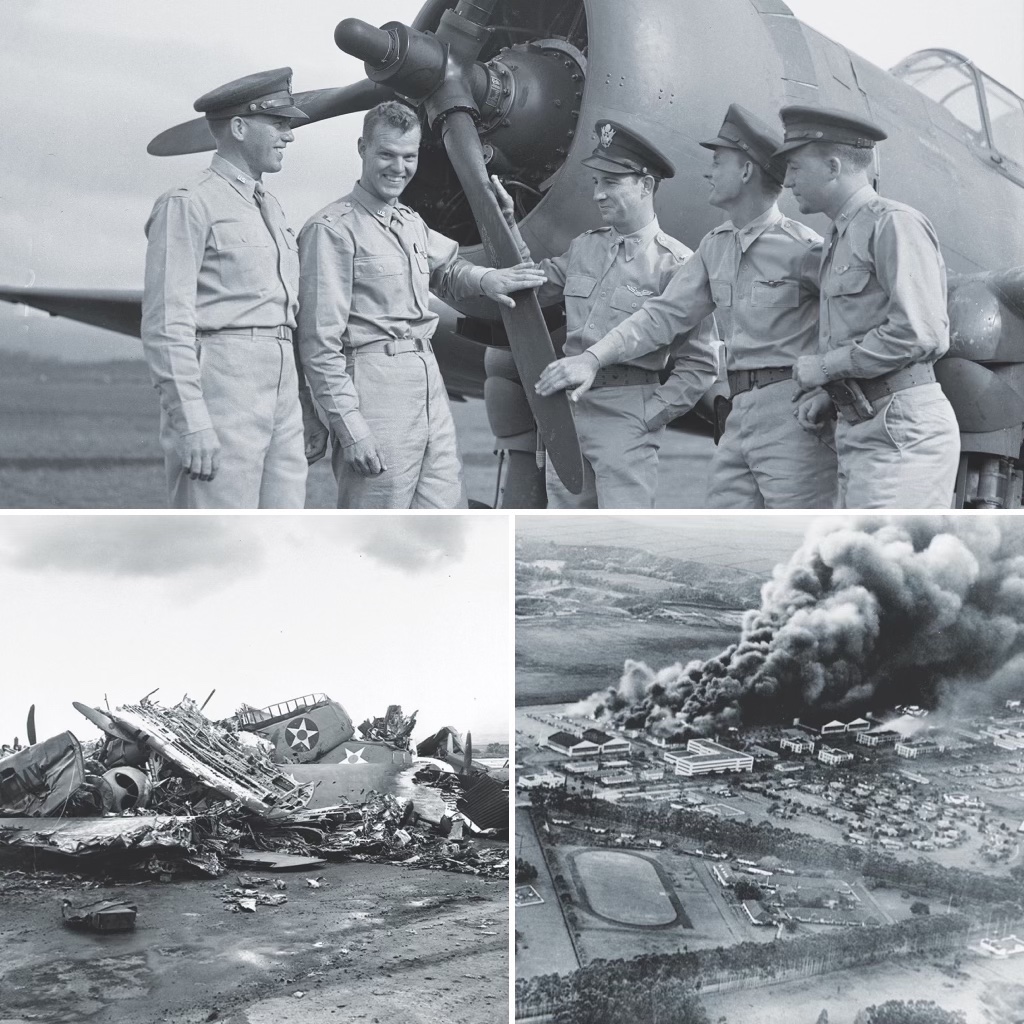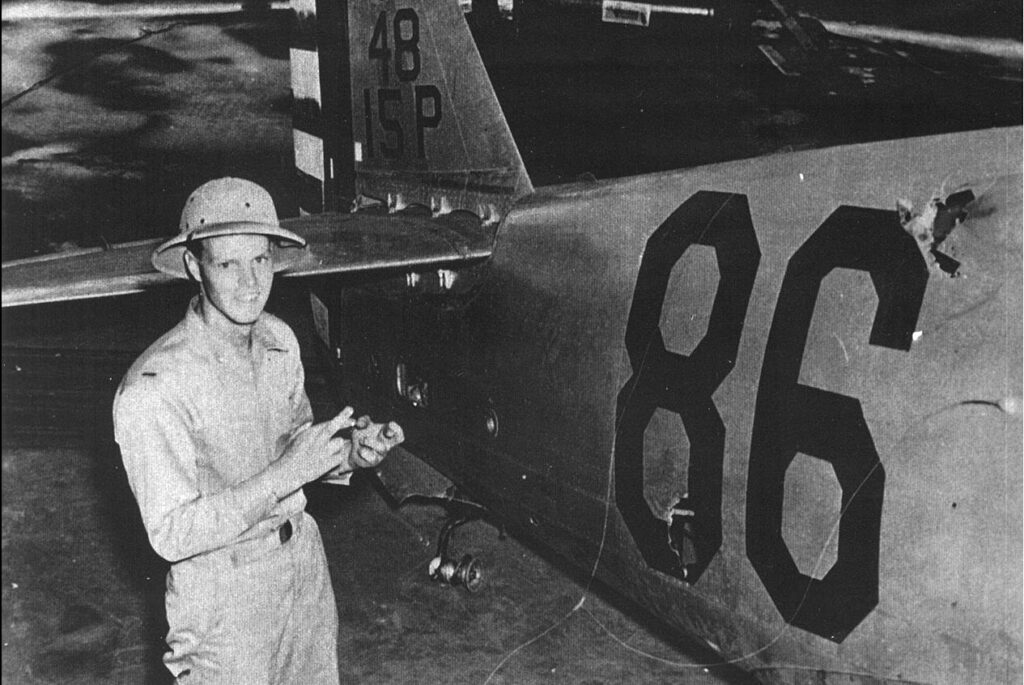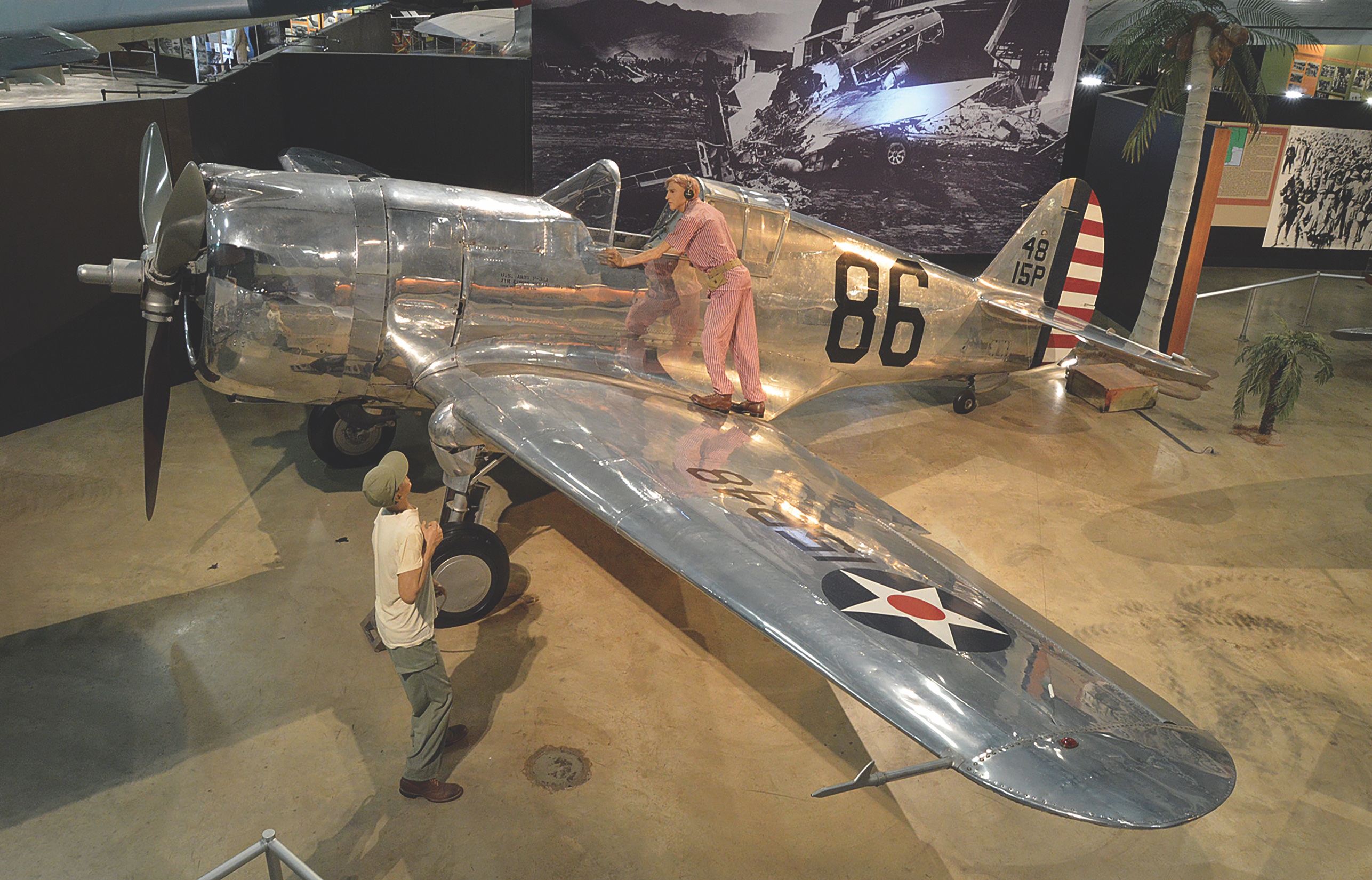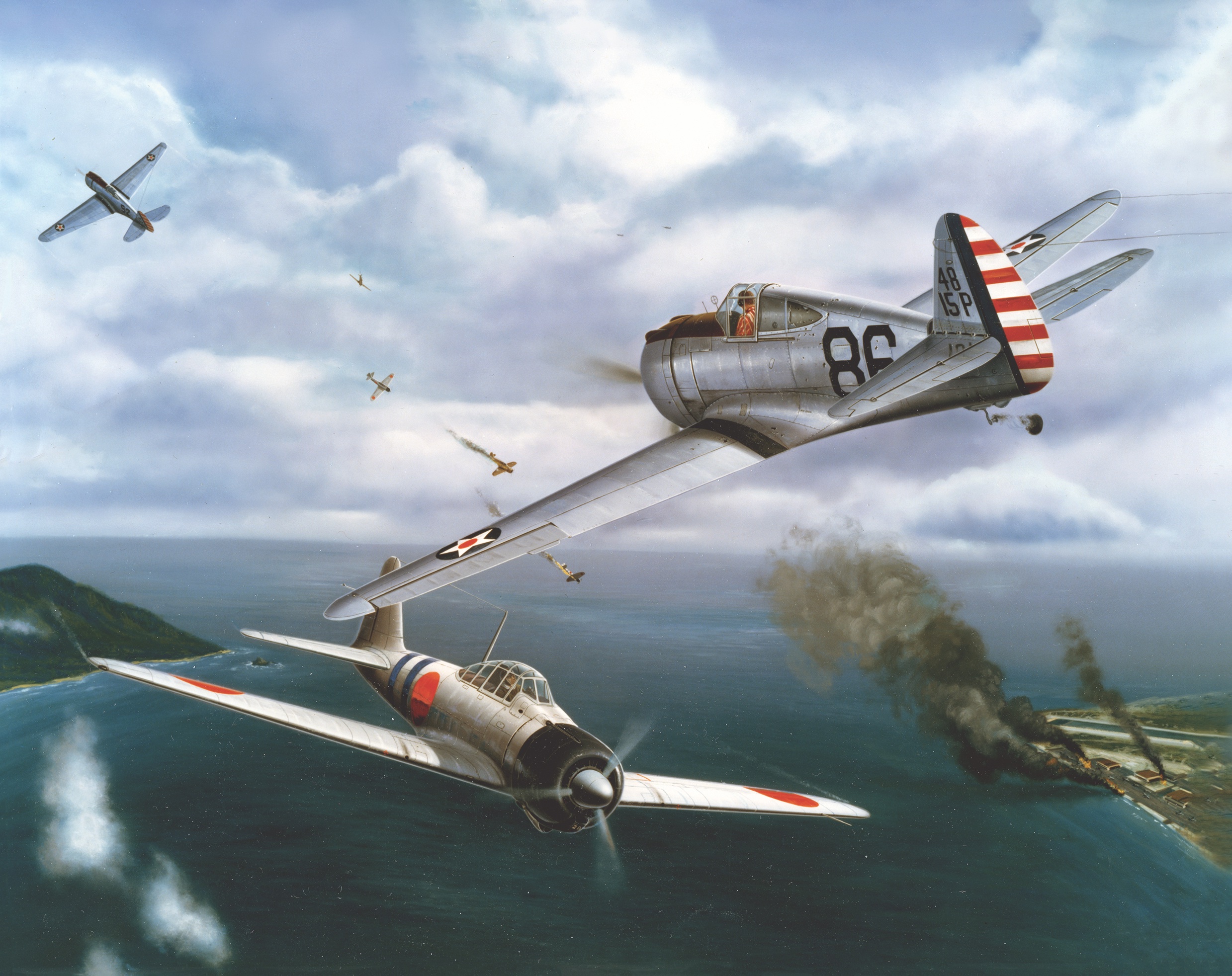When Japanese planes attacked Pearl Harbor on the morning of December 7, 1941, Philip M. Rasmussen was a 23-year-old second lieutenant in the U.S. Army Air Corps. Assigned to the 46th Pursuit Squadron at Wheeler Field on the island of Oahu, he was one of the few American pilots to get into the air while enemy planes were still in the skies over Hawaii. Rasmussen, who would be awarded a Silver Star for his actions that day, went on to fly many other combat missions in World War II, including a bombing run over Japan, for which he later received the Distinguished Flying Cross.
Following assignments in the Pacific, Europe, and the Middle East, Rasmussen became the chief of operations at Eglin Air Force Base, and he retired in 1965 with the rank of lieutenant colonel. He died in 2005 at age 86 and is buried at Arlington National Cemetery.
The following narrative is adapted from an oral history interview with Rasmussen that was conducted in 1991.
I entered into flight training in September of 1940. I completed my training [at] the end of April ’41 and then immediately was transferred to my first assignment, which was to Wheeler Field. Our mission was to defend against the airborne attack on the islands. There was no mention of another country, but I’m sure we all had various feelings about the potential that we were going to be involved in a war with Japan.
In fact, in my diary, I mentioned on December 2 that I had gotten a letter from my father and he thought that we were going to have trouble with the Japanese. And on December [5] I made a comment in my diary that the diplomatic efforts between United States and the president had failed, and it looked serious. But at the same time we’re thinking: “We’re 3,000 miles from Japan. How could anything happen here?”
We never had identification photos of Japanese aircraft. In fact, when we got in a fight and when a Japanese aircraft arrived, I was confused about which ones were fighters and which ones were bombers. We had heard some rumors about the Zeroes being a very maneuverable aircraft, built very lightly and having pretty fair firepower, and that was about it.
About 10 minutes to 8 [on the morning of December 7], I was in the barracks for the unmarried officers. I was standing in the latrine and looking out the window at the hangar line, which was about three, four hundred feet from where I was standing. And I noticed an aircraft dive down [at] the hangar and pull up very sharply, and an object dropped from this plane. And then I saw this huge orange explosion of smoke and orange flames. And when this airplane pulled up, I saw the two meatballs, or the two round circles identifying it as a Japanese aircraft. I knew immediately that it was a Japanese aircraft.
I yelled down the hallway—I was in my pajamas—and I yelled down the hallway that we were being attacked by the Japanese. And I ran to my room and I strapped a webbed belt around my waist and, and a 45-caliber pistol in my holster that was on this belt, and put on a pair of shoes and ran for the flight line.
And as I was running toward the flight line, aircraft were strafing—well, I thought they were strafing and trying to shoot me, because I could hear these bullets whistling by me and I’m sure that they had far more serious objectives than hitting this lone guy running along down toward the flight line.

I wasn’t wasting any time because, as I was running down toward the flight line, I saw the airplanes were lined up wingtip to wingtip. And the Japanese had started to bomb and strafe the aircraft at the end of the line. Each airplane was exploding and igniting the one next to it because they were so close together. There were a few [Curtiss] P-36s that were closer to the hangar line, a little farther away from the other aircraft. And I ran down to one of those and jumped into that plane, got it started, and then an armorer came over with a belts of 30-caliber and 50-caliber ammunition on his shoulder, then jumped on the wing.
I taxied over during, apparently, a lull there, because as I taxied over toward earthen revetments surrounding the airfield, I don’t recall being attacked. As I looked around I didn’t see any aircraft that looked like they were about to strafe me. I managed to get over to one of the earthen revetments, and the armorer and I proceeded to load the P-36 with the 30-caliber and 50-caliber ammunition. The guns on the P-36 fired synchronously through the propeller, and the 30-caliber was on the left side of the pilot and the 50-caliber was on the right side.
You think of machine-gun fire as being a very rapid sound, but because you couldn’t shoot your prop, you had to shoot between the prop as the prop turned. It was sort of almost like a funeral cadence in speed.
As we assembled the four aircraft, Lou Sanders, the squadron commander, and Gordon Sterling and John Backer and myself, we all had done exactly the same thing that I described myself as doing, when I taxied the aircraft over.
And we took off in formation, headed toward Pearl Harbor, to make a turn to the north and we came around the field, circled around the field, climbing. We headed north because along the whole mountain range to the east, the clouds had built up over the mountains. We were trying to remain out of the clouds, and climbed to altitude and just clawing for altitude, because that was so important, in combat, to have altitude. We had that much sense.
We charged our guns at this time. In the P-36, you had a charging handle for each gun. You pull back a lever, pull it back as far as your ear, and then you let it snap forward, and that arm would snap forward and put a bullet in your chamber. Well, I did that with the 30-caliber, and then I pulled the 50-caliber back and let it slide forward, and the gun started firing by itself. So I had to pull it back and keep it cocked to keep the gun from firing. It had nothing to do with me depressing the trigger, because it was a solenoid on that gun that had gone bad on me.
As we climbed we headed east. We had received instructions shortly after being airborne to go to Bellows Field. We were climbing and then trying to get over in that direction as quickly as possible, and as soon as we topped the clouds, at between nine and 10,000 feet, we had instructions to go to Kaneohe Bay, which was more or less on the way to Bellows anyway—same general direction.
[When] we got to Kaneohe Bay, we saw that it was under attack. We saw about eight aircraft that were over land, making a turn, preparing to make another attack on Kaneohe Bay. And we dove down and were going to jump these aircraft—in other words, attack them. We intercepted them at about 6,500 feet. We had all separated in the process of making our attacks, individually, and this one airplane came by from my right side to the left. I lit him with my 50-caliber and let the handle slide home, and it started firing all by itself. I could see the bullets stitching the fuselage, and from the engine aft, and he caught on fire and peeled down.
Just at that same time, this other Japanese aircraft tried to ram me. I was convinced that he was trying to ram me and I pulled up very sharply to my right. And as I pulled up to my right, my airplane shuddered, and my canopy blew off and I lost control of the plane momentarily.
As the plane was falling off, I managed to work the controls around, and I found out that my rudder control would not work. The rudder would just slide in and out on either side, which meant that I still had some aileron control and elevator control. I ducked into the clouds that were below us, and in toward the mountains, and stayed in those clouds. There were about eight to 10 cloud covers. I was popping in and out of clouds, trying to stabilize the aircraft, trying to find out whether I’d been hurt or not because I had felt this blow on the top of my head, and I had not worn a helmet. I just had a headset on, and when I had got the airplane finally straightened out a little bit, straight and level, I gingerly reached up to see how much was left of the top of my head. All I found was a bunch of shredded Plexiglas in my hair. I didn’t have a scratch anywhere.

There wasn’t time. Our actions were preceding our thoughts. That’s almost the way I could just describe it. Our actions were sort of programmed. It was a reaction to a situation. I think it’s the best way I can describe it.
Sadly, the feeling of reality didn’t come until my airplane was hit. And then all of a sudden I realized that I was in a great deal of danger, and that’s the reason why I ducked into the clouds and tried to get out of that direction.
Fear didn’t kick in. I guess it’s like an automobile accident. You suddenly crash into somebody and you have a moment’s pause before you start thinking, and then you get pretty nervous about the situation. But all the way back to the field I was so busy trying to keep that airplane in the air that I didn’t have time to think of anything else. I had my control stick way over in [the] right-hand corner of my cockpit in order to keep the airplane level, and I was using my trim tabs like mad and trying to maintain control of the aircraft.
As I was heading back toward Wheeler, Lew Sanders picked me up. He pulled up close to me and was shaking his head and trying to find out what was wrong, and I said, “Everything is okay. I’m all right.” And so he escorted me back to Wheeler. As we came over Schofield Barracks the friendly forces [had] organized themselves pretty well and were starting to shoot at us. But fortunately, they missed us.
The Wheeler Field people knew that we were friendly aircraft. There were no more Japanese around. As I turned on the base legs and put my view down, I noticed [that] my indicator showed my gear was not down. So on final I was pumping hydraulic fluid with the emergency pump to get the gear down. Just before I touched down I got the gear down, and I cut the engine and landed on the wet grass. The dew was still on the grass. We had no runway. It was just a grassy field, and we had a concrete ramp for parking the aircraft. But the aircraft just took over by itself because I had no brakes—my hydraulics had been shot out. I had no rudder. I couldn’t control the torque of the airplane, and I just spun around a couple of times till it came to a stop.
And then I sat there in, benumbed, really, and I noticed some men running over from the hangar line to see if I was okay, and I finally got up out of the cockpit. I was soaking wet, and it wasn’t just from sweat. And I got on the ground and I looked at the airplane and just—I was just dazed a little bit. I think that’s the only way I can explain it. I didn’t have any coherent thoughts.
I went back to the barracks and took off my pajamas and put on a flying suit and came back down the line to see what I could do because the ammunition was still exploding in the hangars. All the planes that [were] salvageable had been salvaged in that period of time, and there were very few of them that were salvaged.

This painting actually shows the time that I was hit. You can see the bullet holes in the airplane. The tail wheel is being shot off. My canopy is shattered. It was right after I had shot down one Japanese aircraft. Then [another] aircraft tried to ram me, and I had pulled up to avoid being rammed by him. You can see Kaneohe Bay under attack over here, and this is John Thacker, one of our group of four pilots, whose guns were all jammed. He couldn’t do anything. And this is Lew Sanders, who was after this [Japanese aircraft]. And this is our fourth man, Gordon Sterling, who was on fire and was shot down.
This Japanese pilot is still alive. He is quite ill, but he’s in Japan and he’s described how he tried to ram me.
And inside the fuselage shows the hole made by the entry of the 20 millimeter, and when it exploded, these radios absorbed the shock. I had no armor plate in back of me in these airplanes, and what saved my life was these radios that absorbed the shock.
It was like the age of chivalry, almost, with the knights and the way they were fighting and the combat that we engaged in, in World War II. That’s something that disappeared, like horse cavalry. I don’t anticipate, in any future war, that we’re going to have the type of dogfighting that we had. Most of the weapons that we use today fire at targets that are out of sight and that are picked up electronically. So the likelihood of this type of combat, this is part of history. MHQ





